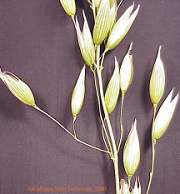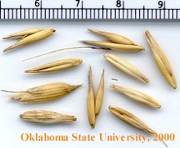|
|
 |
| Welcome | Getting Started | Resources | Site Map |
Week 2
High-Energy Feedstuffs |
Instructions for listening to audio clips
- Download the QuickTime Player to listen to the audio files.
- Read the QuickTime Instructions for installation help.
- Download the RealPlayer to listen to the audio files
- Instructions are on the RealPlayer download page
Oats
Time: 2.43
Follow along with the audio...
- In U.S., fourth most important grain
- Estimated production 116 million bushels
- Grown in northern regions
- Short growing season
- Estimated average yield 61.3 bushels per acre
- Three primary varieties white, red, and gray
- Majority white
- Figure 4.14 Oat grain on the head
- Figure 4.15 Oat grain
- Primarily hull varieties
- Coarse grain
- Nutritional value
- Table 4.5 Average nutrient composition of oats
- Energy source
- Lowest energy value
- Highest fiber
- Lowest starch
- Protein source
- Protein content similar to wheat and barley
- Amino acid content favorable
- Remain deficient in methionine, histidine, tryptophan, and lysine
- High lipid content
- Energy and palatability
- High mineral content
- Feeding livestock
- Palatable
- Lipid content and nature of hull
- Processing to improve nutritional value
- Slower rate of digestion
- Heavy weighted oats
- Higher nutritional value energy
- Swine
- Fed to young and finishing animals
- Ruminants
- Fed to young and breeding animals
- Horses
- Generally, favorable
- Low energy, high fiber, palatability
- Poultry
- Rarely fed
- High producing animals
- Low energy will limit production


Nutrient
|
Average Composition,
% |
|---|---|
Crude protein |
12.8 |
Ether extract |
4.7 |
Crude fiber |
12.2 |
Ash |
3.7 |
NFE |
66.6 |
Starch |
41.2 |
| |
| Welcome | Getting Started | Resources | SiteMap |